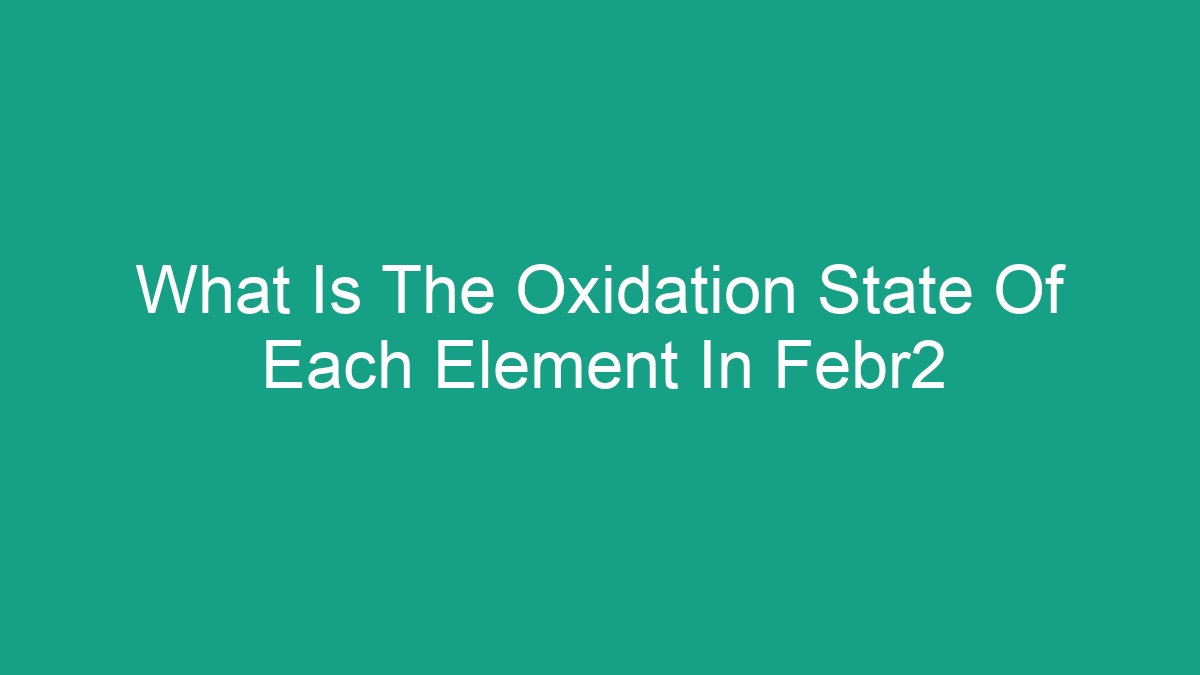
Introduction to FeBr2
FeBr2 is the chemical formula for Iron(II) bromide, which is a chemical compound composed of iron and bromine. It is commonly used in the synthesis of organic compounds and as a catalyst in various chemical reactions. In order to understand the oxidation state of each element in FeBr2, it is essential to have a basic understanding of oxidation states and how to determine them.
What Is Oxidation State?
The oxidation state of an element is a measure of the degree of oxidation of an atom in a chemical compound. It is an important concept in chemistry as it helps in understanding the chemical behavior of elements in various compounds. The oxidation state is represented by a positive or negative number, which indicates the number of electrons that an atom has gained or lost, or shared with other atoms in a compound.
Determining the Oxidation State of Iron in FeBr2
FeBr2 is composed of iron (Fe) and bromine (Br) atoms. In order to determine the oxidation state of iron in FeBr2, we need to consider the following factors:
- The overall charge of the compound, which is neutral in the case of FeBr2
- The known oxidation state of bromine, which is -1
- The rule that the sum of the oxidation states of all atoms in a neutral compound must be zero
Using these factors, we can determine the oxidation state of iron in FeBr2 as follows:
| Element | Oxidation State |
|---|---|
| Fe | x |
| 2Br | -1 |
Since the overall charge of FeBr2 is neutral, the sum of the oxidation states of all atoms must be zero. Using this information, we can solve for the oxidation state of iron:
2(-1) + x = 0
-2 + x = 0
x = +2
Therefore, the oxidation state of iron in FeBr2 is +2.
Determining the Oxidation State of Bromine in FeBr2
Now let’s move on to determine the oxidation state of bromine in FeBr2. In this case, the oxidation state of iron has already been determined to be +2. Using the same factors as before, we can determine the oxidation state of bromine in FeBr2 as follows:
| Element | Oxidation State |
|---|---|
| Fe | +2 |
| 2Br | x |
Since the overall charge of FeBr2 is neutral, the sum of the oxidation states of all atoms must be zero. Using this information, we can solve for the oxidation state of bromine:
+2 + 2x = 0
2x = -2
x = -1
Therefore, the oxidation state of bromine in FeBr2 is -1.
Conclusion
In conclusion, the oxidation state of iron in FeBr2 is +2, and the oxidation state of bromine in FeBr2 is -1. Understanding the oxidation states of each element in FeBr2 is crucial for predicting and understanding its chemical behavior in various reactions. By applying the principles of determining oxidation states, we can analyze the properties and reactivity of FeBr2 in different chemical processes.
FAQs
1. What is the significance of determining the oxidation state of each element in FeBr2?
Determining the oxidation state of each element in FeBr2 is significant as it helps in understanding the chemical behavior and reactivity of the compound in different reactions. It also provides important information for predicting the products of chemical reactions involving FeBr2.
2. Are there any other chemical compounds similar to FeBr2 in terms of oxidation states?
Yes, there are several chemical compounds that involve elements with varying oxidation states, similar to FeBr2. Examples include MnO2 (Manganese dioxide) and CuCl2 (Copper(II) chloride).
3. Can the oxidation state of an element in a compound change under certain conditions?
Yes, the oxidation state of an element in a compound can change under specific chemical conditions. This phenomenon is known as oxidation-reduction (redox) reactions, where the oxidation states of the elements involved undergo changes.
4. Is the determination of oxidation states applicable to all chemical compounds?
Yes, the principles of determining oxidation states are applicable to all chemical compounds. Understanding the oxidation states of elements is essential for analyzing the behavior of compounds in various chemical reactions.



